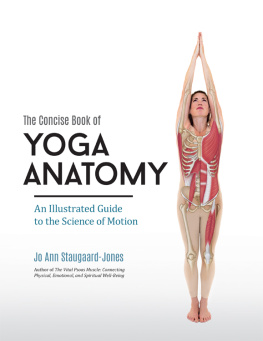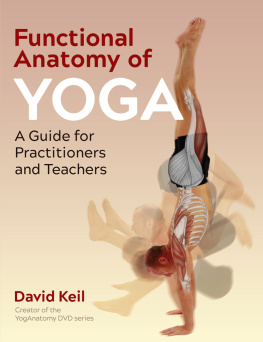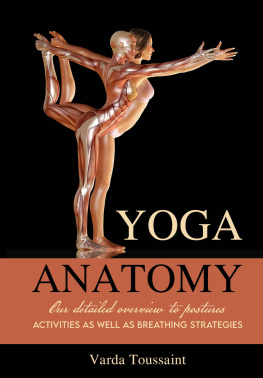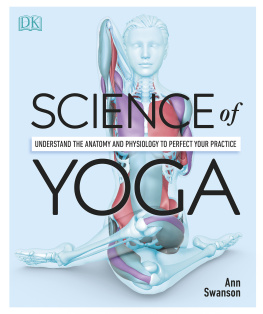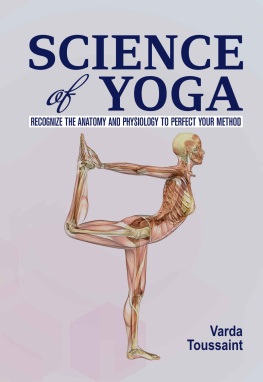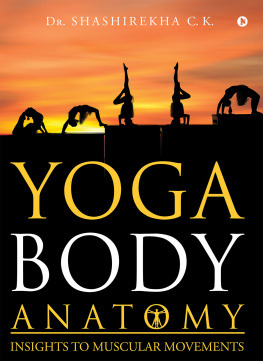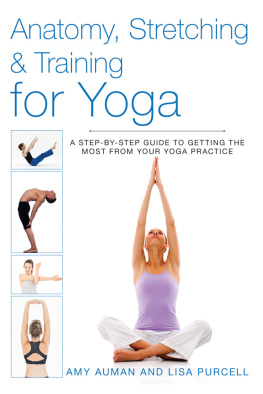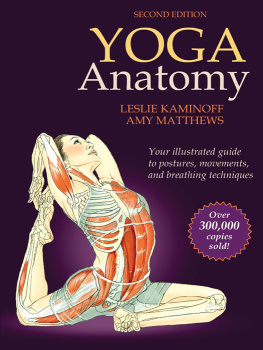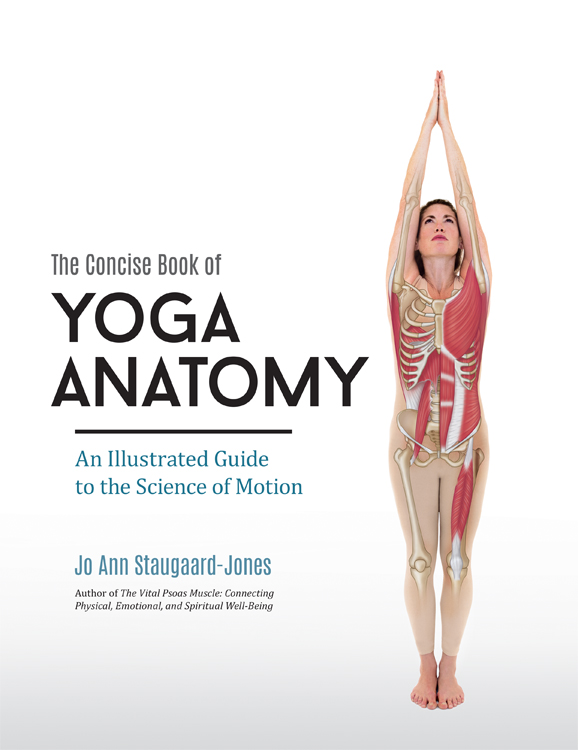The Concise Book of Yoga Anatomy
An Illustrated Guide to the Science of Motion
Jo Ann Staugaard-Jones

Chichester, England

North Atlantic Books
Berkeley, California
Copyright 2015 by Jo Ann Staugaard-Jones. All rights reserved. No portion of this book, except for brief review, may be reproduced, stored in a retrieval system, or transmitted in any form or by any means electronic, mechanical, photocopying, recording, or otherwise without the written permission of the publisher. For information, contact Lotus Publishing or North Atlantic Books.
First published in 2015 by
Lotus Publishing
Apple Tree Cottage, Inlands Road, Nutbourne, Chichester, PO18 8RJ and
North Atlantic Books
Berkeley, California
All Drawings Amanda Williams
Text Design Wendy Craig
Cover Design Jasmine Hromjak
Printed and Bound in the UK by Bell and Bain Limited
The Concise Book of Yoga Anatomy: An Illustrated Guide to the Science of Motion is sponsored and published by the Society for the Study of Native Arts and Sciences (dba North Atlantic Books), an educational nonprofit based in Berkeley, California, that collaborates with partners to develop cross-cultural perspectives, nurture holistic views of art, science, the humanities, and healing, and seed personal and global transformation by publishing work on the relationship of body, spirit, and nature.
North Atlantic Books publications are available through most bookstores. For further information, visit our website at www.northatlanticbooks.com or call 800-733-3000.
Disclaimer: This book offers health and movement information and is for educational purposes only. It is not a substitute for, nor does it replace, professional medical advice, diagnosis or treatment of health conditions.
British Library Cataloguing-in-Publication Data
A CIP record for this book is available from the British Library
ISBN 978 1 905367 56 6 (Lotus Publishing)
ISBN 978 1 58394 983 2 (North Atlantic Books)
Library of Congress Cataloging-in-Publication Data
Staugaard-Jones, Jo Ann, author.
The concise book of yoga anatomy : an illustrated guide to the science of motion / Jo Ann Staugaard-Jones.
p. ; cm.
Includes .
ISBN 978-1-58394-983-2 (pbk.) ISBN 978-1-58394-984-9 (ebook)
I. Title.
[DNLM: 1. Yoga. 2. Kinesiology, Applied. 3. Musclesphysiology. QT 260.5.Y7]
RA781.7
613.7046dc23
2015013328
Contents
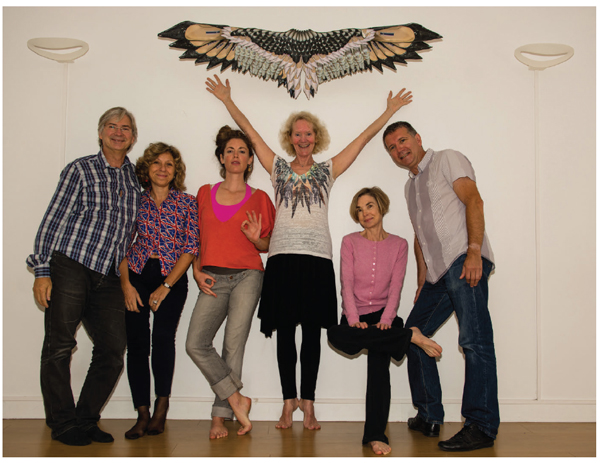
Thank you, Paris models and Atelier Marais Studio!
From left to right:
Reinhard Fleer, Paris, France; Molecular Biologist, Amateur Photographer.
Claire Bertin, born and raised in Paris, France; French and Comparative Literature teacher, writer.
Ingy Ganga, from France, Egypt, and Turkey; Yin/Hatha Yoga teacher and soul singer in Paris.
www.ingyganga.in
Jo Ann Staugaard-Jones, Cranberry Lake, NJ; Author, Yoga Anatomy Teacher Trainer.
www.move-live.com
Jo Ann Hegre, an American who has lived in Paris for 25 years; Geologist; spends her time hiking and biking; an ex-dancer who now does yoga.
Ren Montaz-Rosset, Paris, France; Engineer; spends his time hiking, biking, skiing; started doing yoga in 2011.
All photo shooting on the premises of:
Atelier Marais
54, rue Charlot
75003 Paris
http://www.atelier-marais.fr
http://www.b-y-p.be
About this Book
This book is designed in quick-reference format to offer useful information about the main skeletal muscles that are central to yoga. It is my belief that yoga styles that include the limb of yoga called asana (which has evolved to become a term that signifies all yoga postures) should be taught and practiced in a way that is comfortable, stable, balanced, and without pain. Understanding the science of the body and of motion will help one to achieve this.
To assist your understanding of the biomechanics of the body, each muscle section is color-coded for ease of reference. Enough detail is included regarding the muscles origin, insertion, and action to meet the requirements of the student, practitioner, and teacher of all yoga movement. The book aims to present that information accurately, in a clear and user-friendly format, especially as anatomy and kinesiology can seem heavily laden with terminology. Technical terms are therefore explained throughout the text.
Major muscles are identified and asana illustrations help to show how they are working in relation to the particular posture. Each asana is listed in Sanskrit (phonetically, with definition) and English, with sections to describe awareness, joint actions, alignment, technique, helpful hints, and counter poses (postures that are helpful to counteract the illustrated asana). Knowledge of all this is paramount to the ability to teach or practice with no injury to oneself or to others. As mechanics are emphasized and learned, I ask that you take the time to then realize the essence of the pose or movement in relation to the yogic way of life, for it is necessary to focus on the spiritual element of yoga as well as the physical. Yoga is a union of the two, so where appropriate, the more profound side of the practice is mentioned as it relates to the body.
As an example, when one sits in meditation in Sukhasana (Easy Pose), the postural aspects can be the beginning of the process, but as breathing and subtle energies are incorporated, the fundamental nature might be the stillness of the mind in order to reach inner awareness. Explore each posture and consider more deeply what the asana means for you.
In what is termed Hatha Yoga (the foundational form represented in this book), the sun and the moon represent the two polar energies of the human body. The word hatha itself, divided into syllables of ha and tha, suggests the solar and lunar energies. Atha is also defined as now, yoga as union, balance.
When faced with the choice of what yoga style to study, I chose one with strong tradition and science interwoven. Hatha yoga provides the all-important deep breath work, support, strength, flexibility, and progression needed to lead one to a well-balanced and profound practice. Attention is given not only to the gross anatomy stated in this book, but the subtle yet powerful physical and energetic forces of the body as well.
Thus, asana can lead one to going inward, with effortless breath, stillness, and meditation, as complete mastery over the roaming tendencies of the mind is Yoga. (Tigunait, 2014)
In The Concise Book of Yoga Anatomy you will not find the asanas categorized under type, such as Standing, but placed under a specific muscle that is used in that posture. It is yet another way to look at the anatomy of yoga.
As students, guides, and facilitators of yoga, and as human beings looking to understand the physical, mental, and spiritual aspects, we can use yoga as a blueprint toward the study of form and the philosophy of living: do no harm (in Sanskrit,

